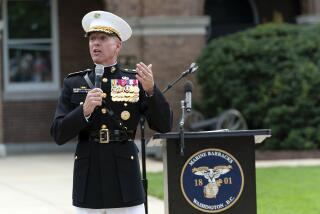Disrupting Command Dooms a Campaign
- Share via
WASHINGTON — For the past several months stories have been circulating in Washington that Gen. John R. Galvin, commander in chief of the U.S. Southern Command in Panama, responsible for overseeing U.S. military operations in Central and South America, will be reassigned to head the North Atlantic Treaty Organization in Europe. If the rumors are right, the decision is wrong.
This would be just one more sign that the United States is bound and determined to make Alexis de Tocqueville into a prophet. Writing in 1835, Tocqueville noted that democracies “can only with great difficulty . . . persevere in a fixed design,” and then must await the consequences patiently. “These are qualities,” he continued, “which more especially belong to . . . an aristocracy.”
As did their aristocratic predecessors, today’s “new czars” (China’s felicitous term for the Soviets and their satraps) know that continuity in leadership is key to pursuit of a “fixed design.” For example, from January, 1959--when North Vietnam committed itself to “armed struggle” to conquer Southern Vietnam--until the fall of Saigon in April, 1975, North Vietnamese Gen. Vo Nguyen Giap served as minister of defense and armed forces commander in chief--a strategic as well as battlefield commander.
Not counting the South Vietnamese leadership, on the American side alone Giap had about 26 counterparts: five commanders in chief (Presidents Dwight D. Eisenhower, John F. Kennedy, Lyndon B. Johnson, Richard M. Nixon and Gerald R. Ford), seven secretaries of defense, six chairmen of the Joint Chiefs of Staff, four strategic military commanders in Honolulu and four battlefield commanders in Vietnam itself.
Like American servicemen in World War II, the Viet Cong and North Vietnamese regulars served for the duration of the war. The tour of Vietnam duty for U.S. servicemen, on the other hand, was fixed at one year. Continuity, patience and pursuit of a fixed design were impossible.
Now we may be doing it to ourselves again in Central America. Since Daniel Ortega and the Sandinistas came to power in July, 1979, the United States has had two commanders in chief (Presidents Jimmy Carter and Ronald Reagan), two secretaries of defense and three chairmen of the Joint Chiefs of Staff. While these changes in political and military leadership at the national level have worked against the pursuit of a fixed design, they can be justified as an acceptable cost of democracy.
What cannot be justified is lack of continuity at the operating levels. Most of the “front-line” states--El Salvador, Honduras, Costa Rica and Guatemala--have had to deal with a succession of U.S. military group commanders since 1979. No sooner does one U.S. commander get his feet on the turf than he’s yanked away and shipped off to another assignment. Pursuing the same “business as usual” logic as during the Vietnam War, the Pentagon has set the tour of duty in Central America at two years.
Even worse is the game of musical chairs at Southern Command itself. Since the Sandinistas took power, overall command of U.S. military operations in Central and South America has changed three times--from Gen. Wallace H. Nutting to Gen. Paul Gorman to the current commander, Galvin. And now bureaucrats in Washington talk about moving Galvin to Europe this summer.
That would be stupid. Galvin is especially qualified to oversee U.S. military policy in Central and South America. With the perspective gained by serving as an adviser to the Colombian military 30 years earlier, Galvin has a deep appreciation and understanding of the area. He speaks fluent Spanish and also requires his commanders and staff officers to be language-qualified.
While he has established strong rapport with political and military leaders throughout the region, he has also worked hard to reverse decades of American military dominance. For the first time in years, U.S. diplomats, not U.S. military officers, now play the leading roles in representing America’s Latin America interests. Galvin has a profound respect for U.S. values and ideals, and has made clear to Latin American political and military leaders that human rights cannot be subordinated to “military necessity.” As long as he’s in command, “win at any cost” is not an acceptable option.
Public attention on the sideshow in Nicaragua has overshadowed the fact that events in Central and South America have been moving in our favor. Authoritarian regimes are giving way to popularly elected democracies and the military is evolving into a professional force subordinate to its political overseers. Galvin has helped advance those developments.
Reassigning him to Europe now, just when things are looking up, could presage disaster. As the Duke of Marlborough warned some three centuries ago: “To remove a general in the midst of a campaign--that is the mortal stroke.”
More to Read
Get the L.A. Times Politics newsletter
Deeply reported insights into legislation, politics and policy from Sacramento, Washington and beyond. In your inbox twice per week.
You may occasionally receive promotional content from the Los Angeles Times.










